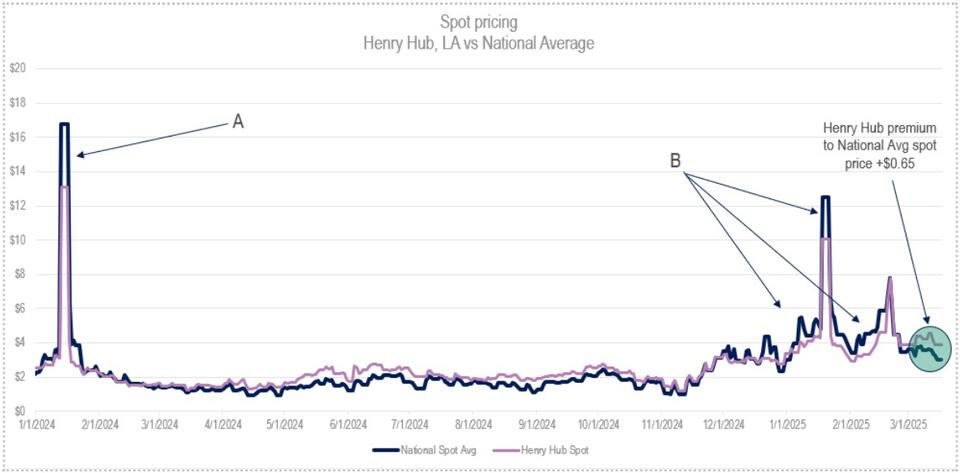Are spot price premiums at Henry Hub an anomaly or a concerning LNG export trend?

By Jeff Bolyard
The Henry Hub natural gas index point is commonly associated with the NYMEX futures settlement location. A significant amount of pipeline infrastructure and volume flows into and out of this area, settling near the end of each month as the prompt futures contract expires.
However, the Henry Hub location is also a daily index pricing point that trades in the spot market for short-term, daily delivery of gas. Unlike the NYMEX futures contract, which only has one benchmark to consider, the Henry Hub spot location is just one of over 100 liquidly traded pricing points that are traded each business day in the spot market.
Over the past four years, Henry Hub spot prices have averaged a discount of $0.29/MMBtu compared to the national average of spot prices at the remaining 100+ liquidly traded spot price locations. This is somewhat predictable for a location like Henry Hub with such an excess of supply compared to other regions. During periods when cold weather typically sweeps across the U.S., demand increases significantly, leading the national spot price average to exceed the spot price at Henry Hub, which is located along the typically mild Gulf Coast.
In the chart below, the Henry Hub spot price (purple line) is compared to the national average spot price (navy line). Highlighted are two such periods of cold weather where the national average spot price exceeded the Henry Hub spot price. Arrow A in January 2024 represents the short-lived winter storm Heather, and Arrows B represent a much more extended cold spell, which ended up being the coldest combined January/February in a decade.

However, since the beginning of March, the national average spot price has been trading at a discount to the Henry Hub spot price by an average of $0.65/MMBtu, rather than the usual premium. This anomaly is typically reserved for the spring to late fall periods, when domestic demand is lower and excess pipeline capacity supply is abundant. The question is this: why has there been an abnormal shift where the Henry Hub is now a significant premium in the spot market?
With the commissioning of Plaquemines LNG, which is nearing 2 Bcf per day, and the recent consistently strong output of the existing LNG exporters, LNG exports are at an all-time high. They have been averaging 15.8 Bcf per day, 3 Bcf per day higher than March 2024. This increase points to significant demand growth, particularly for a single region. Most LNG exports are aggregated along the Gulf Coast, which is, coincidentally, in the same proximity as Henry Hub and interconnected to several of the same pipelines and assets that can impact Henry Hub pricing indices.
Would it be unreasonable to think that growing regional LNG demand along the Gulf Coast is creating a spot price premium at Henry Hub, while slower natural gas demand elsewhere might be reflected in NYMEX futures? If so, the NYMEX futures benchmark at the Henry Hub would have a disconnected price premium from most areas of the country going forward as the LNG demand grows in that region. Meanwhile, the overall price in the majority of the country would trade at a discount to the benchmark. Under this scenario, a budget would be negatively impacted under a gas purchase contract structure tied to the NYMEX LDS benchmark location of the Henry Hub.
By far, the most common way to protect the price of natural gas has been to hedge the NYMEX Henry Hub portion of cost. However, other risk management tools and contract structures offered by physical and financial commodity markets protect price risk going forward without being tied to the NYMEX Henry Hub. This includes various regional indices and other derivatives, all of which come with their own benefits and risks.
With this new price trend in the spot market and the potential for a similar impact carrying over to the NYMEX benchmark, it may be time to consider reviewing your risk management strategy and the available options in the market.
